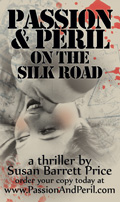Kathleen's Machine: Home Audio Recording in the Days Before Tape
A 6-min documentary: Kathleen Barrett Price tells her story of recording voices during the 1940s. In figuring out how to use a "home disk recorder," Kathleen not only managed to preserve her youthful memories, but also captured the vibe of a special time and place. (Also on PRX)
World War II was raging; her brother had been killed. But, doing what the Irish do best, the family found solace in song and laughter. In the basement space beneath the family's grocery store and tavern in north St Louis, they hosted parties. Over the course of three years, Kathleen and her sister Mary Hohmann set up the machine to capture the warmth and hilarity of these gatherings. The results form the crowded "memoryscape" that accompanies her reflections here.
The piece is 6 minutes long. It consists of KBP's interview in 2005 and cuts from her records. No other audio was added.
Background. Kathleen's family owned Barrett's Market grocery store and All Inn tavern on the corner of Rowan and Ridge in north St. Louis. The large basement of the building was used for parties.
At the time of these recordings Kathleen lived in the apartment above the store with her mother and step-father (Catherine and Ewald Curran) and her brother Bill Barrett. Her sister Mary lived nearby with her husband Lester Hohmann and their two young children. Her brother Bob had been drafted after Pearl Harbor and played saxophone in the Army Band, but was killed in an airplane crash in May 1942.
Twenty-five records were preserved. The first of these recordings was made at the end of a long New Year's weekend, Jan 2, 1943. Recordings continued at assorted Halloween, Valentine's, Christmas, and welcome-home parties through 1946.
 Recording device. Kathleen's machine existed in that blink of time after the first commercially available electrically-recorded disks and magnetic tape. The recording device was a portable turntable in a "snakeskin" case. An innovation up from the hand-cranked acoustical Victrolas, it was electrical. This "home disk recorder" cut analog grooves direct-to-disk (see disk manufacturers below). The brand name and model for Kathleen's Machine is lost in time, but we believe it was a Wilcox-Gay (see David Morton note below).
Recording device. Kathleen's machine existed in that blink of time after the first commercially available electrically-recorded disks and magnetic tape. The recording device was a portable turntable in a "snakeskin" case. An innovation up from the hand-cranked acoustical Victrolas, it was electrical. This "home disk recorder" cut analog grooves direct-to-disk (see disk manufacturers below). The brand name and model for Kathleen's Machine is lost in time, but we believe it was a Wilcox-Gay (see David Morton note below).
References & Notes
Recording Technology History by Steven Schoenherr
David L Morton PhD: "...by 1942 there were not very many options for buying a home recorder... It's almost certainly a Wilcox-Gay or a Silvertone (from Sears, manufactured by somebody else, probably Wells Gardner). From your description is sounds like a Wilcox Gay recordio, probably like this one:http://pat.kagi.us/d/15104-2/2006_Nov_misc_031.jpg (original source is http://www.davesvintagestuff.com/2008/11/recordio-discs-homemade-records-1940s.html)
There were only a few companies at that time that were still making home recorders (the market had died out in the 20s but would bounce back after WWII, however, then quickly disappear when wire and tape recording came along around 1949). Incidentally, if she did buy the recorder in '42 then she must have gotten one of the last prewar models. Wilcox -Gay began to shut down its consumer production lines during early '42 and started making all sorts of things for the military." (personal correspondence, 5/16/09)
Wilcox-Gay Recordio Disc, Charlotte, Michigan. Most popular brand of amateur home recording disc blanks in the 40's and 50's, with metal or stiff paper cores (source)
Howard Recording Disc, Howard Radio Co, Chicago. "Slow Burning"
Duodisc Aluminum On label: "Use Duotone Cutting and Transcription Needles for Best Results" Lacquer on aluminum disk.
Crosley Home Recording Disc, The Crosley Corporation, Home of WLW, Cincinnati, Ohio. Lacquer on metal.
The Recordisc Corp, 395 Broadway, New York City "Instantaneous Recording Blanks. Type N1, 1941. Slow Burning" and "Type Professional, copyright 1942." Can be recorded inside out or outside in.
5.14.09
BROADCAST
4.25.10 Kathleen's Machine: Home Audio Recording in the Days Before Tape was licensed for broadcast by WAMC/Northeast Public Radio (NY, MA, CN, VT, NJ, NH, PA), 90.3 FM and nationally
11.16.10 Kathleen's Machine: Home Audio Recording in the Days Before Tape was licensed for broadcast by REMIX, a 24-hour noncommercial public radio channel distributed on XM 136 for satellite radio, offered as HD/broadcast for local noncommercial radio, and simulcast on internet/mobile.


